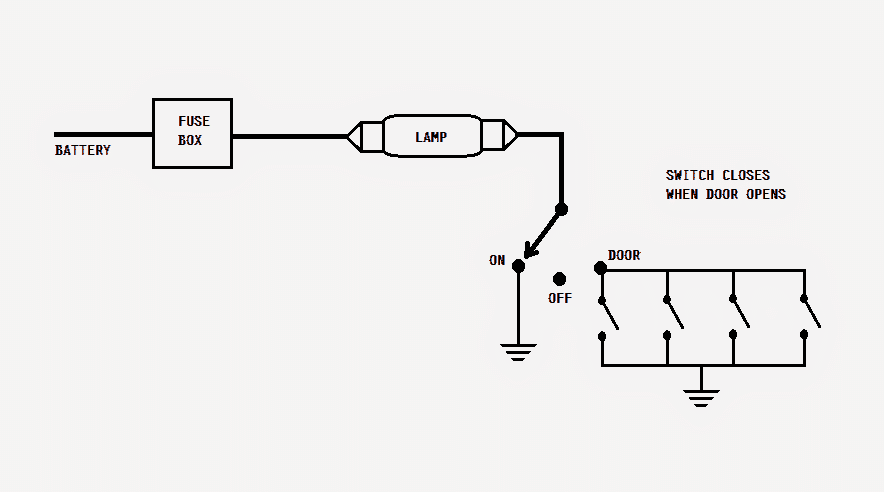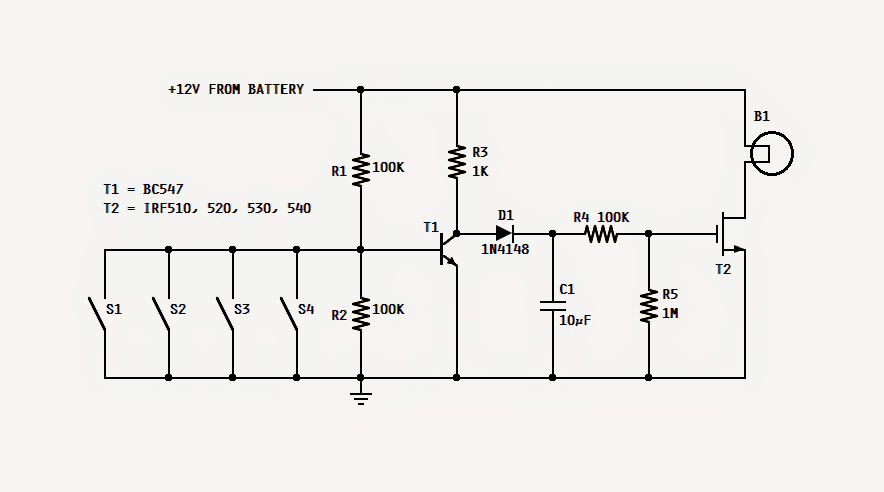In this post I will explain a simple circuit which can be used for producing a slow fading light effect each time it's switched OFF. The application can be typically used in car interior lights.
Designed by: Abu-Hafss
The Circuit Concept
Most of the modern cars are equipped with circuitry which switches on the Car's room lamp when a door is opened and switches off the lamp in fading manner when the door is closed.
Here a simple circuit is presented which can be installed in old cars without any major alterations to get the same effect.
Before we understand the description of the circuit, it is important to understand the wiring of a Car's interior lamp and how the door switches are operated.

The lamp is connected to the battery's positive thru a fuse. The other end of the lamp is connected to a single-pole-3-throw switch.
When this switch is positioned at ON, the other end of the lamp gets connected to ground i.e. the negative terminal of the battery hence, the lamp gets illuminated.
In OFF position, the lamp remains disconnected from the ground. In DOOR position, the lamp gets connected to the ground via door switches (in parallel). When a door is opened, the corresponding door switch is closed.

How it Works
Referring to the proposed car interior light fader circuit, when any of the door is opened, its switch is closed hence, the base of T1 gets connected to ground and thus stop conducting. In this state, C1 gets charged rapidly via R3 and D1.
As soon as C1 is charged, the mosfet is fed with the gate voltage thru R4 and thus it starts conducting and consequently the lamp is illuminated.
Now, when that door is closed, its switch gets open. The base of T1 gets disconnected from the ground and is held at a voltage delivered by the R1/R2 voltage divider.
This action switches on T1, and the voltage coming from R3 finds it way to ground thru emitter of T1.
The switching on of T1 deprives C1 of its charging current and thus C1 starts discharging slowly thru R4 and R5. The gate voltage of T2 reduces as C1 discharges.
With this reduction in the gate voltage the intensity of the lamp is also reduced. Finally, when the gate voltage goes below the threshold voltage the lamp switches off.
The values of R5 and C1 are responsible for the fading delay time of the lamp. Increasing the values will increase the time and vice versa.
T2 should be any suitable N-channel mosfet capable of handling at least 50V and 10A. The whole circuit can be built on compact sized general purpose board and enclosed in the room lamp cover.
Hallo!
I am a civil engineer, and i don’t know much about electronics. But i have 1 question. Won’t that circuit eventually drain the battery of my car (if i leave my car parked for a period of time), through the R1 and R2?
With regards.
Hello, yes that can happen. However the lamp power can be very small which might allow a very long time for the battery to drain. Alternatively you can use LED lamps to make the draining process negligible.
Hi Swagatam,
Just one more question if you don’t mind? What transistor do you recommend for my application?
Thanks again for all your help so far
Regards
Patrick
Will this circuit also work with an led light. ie for the ignition switch so you can see where to put the key at night. I am thinking just one LED. Thank you for your kind assistance. Regards, Patrick
Yes sure, just replace the lamp with an LED having a series 1 K resistor.
Thank you very much Swagatam. I appreciate your help and advice. I will try this circut and see how to make the timing 10 seconds by playing with the capacitor and resistor combination. I have som small N channel mosfets which I will try. I doubt that I need a 10 amp mosfet for a single LED.
Thanks again.
Thanks Patrick, yes for an LED a 10 amp transistor will not be required, you can use a BC547 instead.
Swagatam,
Thank you for the answers to my questions. As you will no doubt have gathered that I am not very knowledgeable with electronics so I find it very helpful that you and people like yourself go to the trouble of helping people like myself and I am very grateful. I have lots of BC547’s in my box so I will breadboard the circuit today and let you know how I get on.
Regards
Patrick
No problem Patrick, please go ahead!